Unagi Sushi
Freshwater Eel
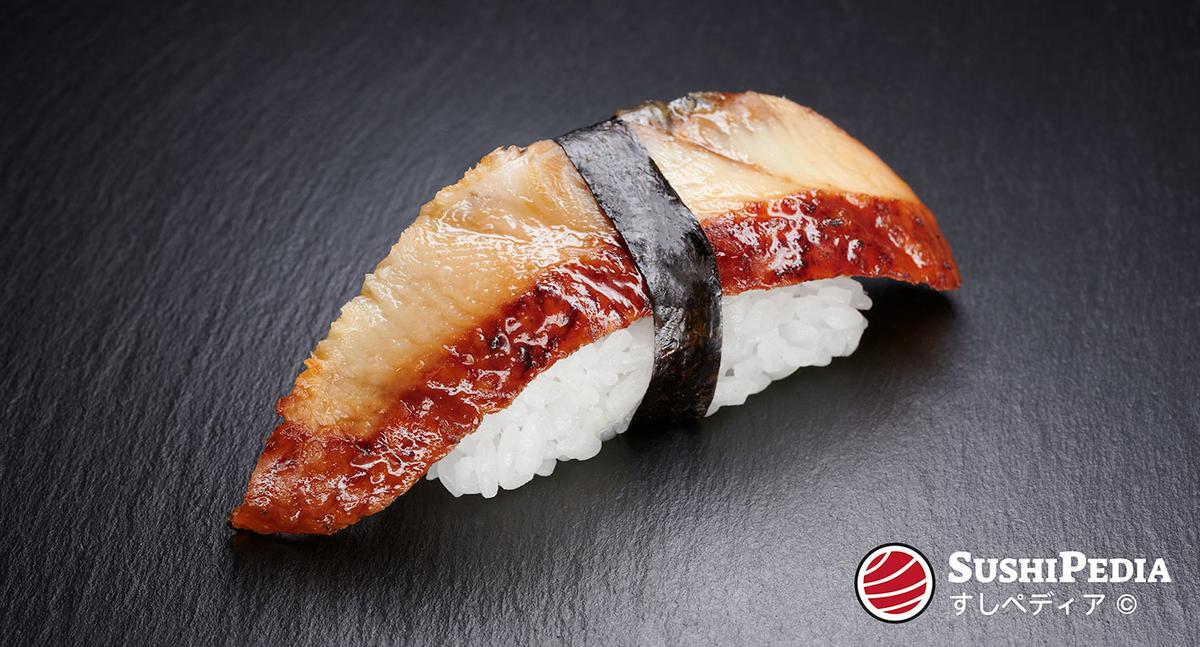
What is Unagi (Freshwater Eel)?
Unagi (ウナギ) is the Japanese word for the genus of freshwater eels and traditionally refers to the Japanese eel (nihon unagi). Unagi is a very popular ingredient in Japanese cuisine and is considered one of the most expensive food fish in Japan [Ottolenghi et al., 2004].
Freshwater eel is not considered a classic sushi ingredient. However, nowadays it is regularly encountered as sushi, especially outside Japan.
Unagi as Ingredient for Sushi or Sashimi
Unagi is rich in protein, vitamins and minerals. The cooked meat has an unmistakable taste which distinguishes it significantly from other fish. The prepared meat of unagi is very soft and fluffy, pleasant on the palate and usually without a fishy or earthy aftertaste. The high fat content gives it a full-bodied flavour, which can be enjoyed with a spicy soy-based sauce (kabayaki) or sprinkled with salt alone (shirayaki).
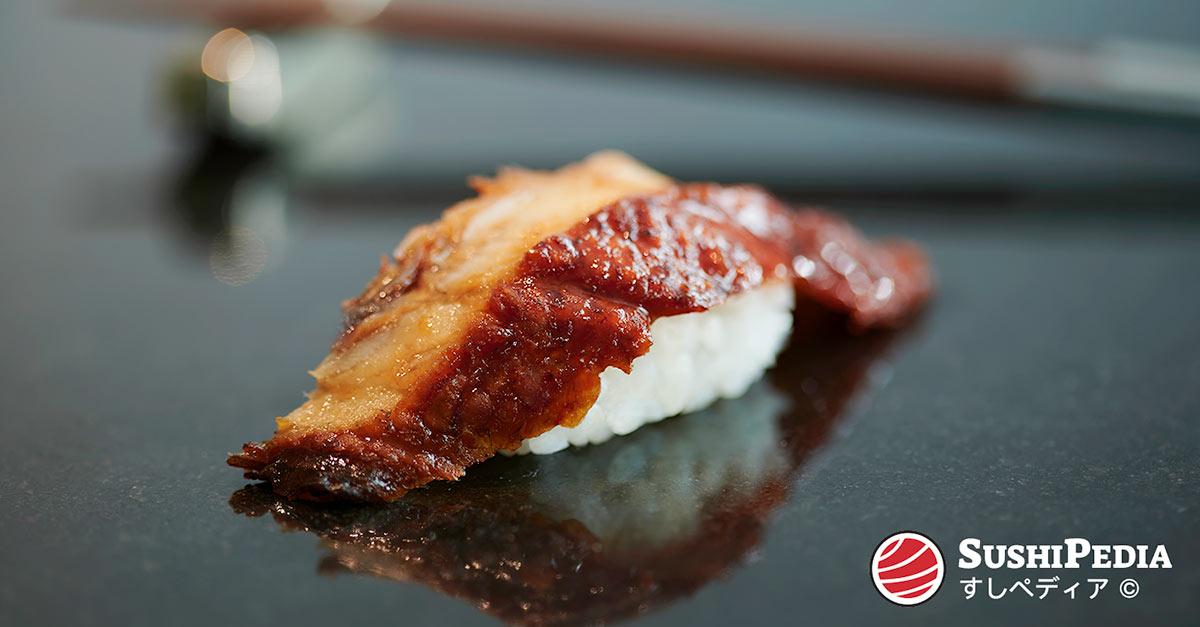
The mucous layer of the unagi can emit an unpleasant odour depending on the habitat and food. Therefore, both natural captive and farmed unagi are placed in clean water for one or two days before they are killed. The Japanese method of preparation of unagi follows several successive steps. First, the eel is cut open and filleted either at the head or on the ventral side, starting lengthwise. The meat is then cut into pieces of equal size, placed on skewers and gently roasted over charcoal. In the next step, the fillets are steamed and then dipped in sauce to be roasted again on the grill.
Occasionally the prepared meat from the unagi is sprinkled with Japanese pepper (sansho, サンショウ) to give the meat a fresh smell. In addition, sansho is said to have a digestive effect which is supposed to support the absorption of the fatty unagi meat. For the preparation of unagi nigiri sushi, it is recommended to refrain from this and prefer sesame (goma, ゴマ) or don't use any garnish at all.
Unagi Sauce (unagi no tare, うなぎのたれ)
Although unagi can be enjoyed without sauce (tare), it is usually served with a thick broth specially prepared (unagi no tare). At the time when the unagi sauce was not commercially produced in large quantities, it was considered an indication of the cook's skills. Nowadays, homemade unagi sauce is only to be found in high-quality or specialities restaurants.
The basic ingredients of unagi no tare are soy sauce, mirin, sugar and sake. Taste and consistency are similar to teriyaki sauce. Although unusual, the taste of the sauce is well suited as an addition to grilled meat dishes.
Unagi vs. Anago
Unagi is not considered a traditional ingredient for making sushi in Japan. Only rarely, or on advance order, you can find unagi as handmade nigiri in Japanese sushi restaurants. Analysis of Google search queries, as well as the evaluation of the advertisements of Japanese sushi chains, indicate an increasing demand for unagi nigri sushi in Japan. More common is the use as an ingredient for pressed Sushi (oshizushi). In contrast, the conger eel (anago) is an essential part of the seasonal menu of a restaurant. Outside Japan, especially in North America and Europe, the situation is the opposite. Since Anago is rarely actively fished outside of Northeast Asia, it is simply too complicated or nearly impossible for most sushi chefs to obtain fresh Anago. Thus, mostly imported, frozen and (in the worst case) already industrially prepared unagi is used. Only in high-quality restaurants fresh and regionally available river eel is prepared.
Compared to anago, unagi is more tasty, fatty and meaty. Moreover, unagi is considered a higher quality delicacy in Japan and is therefore more expensive. In terms of taste, unagi differs from anago by its more intense and full-bodied taste. The common opinion is that anago, because of its lighter taste, harmonises better with soured sushi rice and is therefore the preferred choice for making sushi.
Best Season
Although unagi is traditionally eaten on the “day of the ox” (doyō no ushinohi), late autumn until early winter is considered the best season. During this time, fish build up fat reserves in preparation for winter, when they hibernate in burrows and holes.
Even though unagi is most tasty towards the beginning of winter, unagi is traditionally appreciated in the middle of summer. In Japan they say unagi gives you strength and endurance, which you need especially during the Japanese summer heat to prevent exhaustion.
Wild Capture vs. Aquaculture
Wild-caught unagi (天然ウナギ) has a lighter and less fatty taste than farmed unagi (養殖ウナギ). The meat is harder and the animals are said to be slightly larger. In contrast, aquacultured unagi lacks the smell of mud and soil, has a softer texture and a more consistent taste.
Even if purists prefer wild-caught unagi, it can generally be said that a predominant proportion of consumers consider aquaculture reared unagi more tasty and of higher quality. According to the Food and Agriculture Organisation of the United Nations (FAO), in 2018, approximately 97 % of the unagi production volume came from aquaculture.
Unagi in Japan
In Japan, the term unagi nobori (うなぎのぼり), which can be freely translated as “climbing as an eel”, is similar to the expression “skyrocketing”. It means that the ascent or rise of something or someone progresses rapidly and is usually subject to special conditions and may only be temporary. The term is derived from the habit of unagi that after a certain time they return from the sea and hike up the mountain rivers to return to the ponds and lakes where they originally lived.
Unagi on the Day of the Ox (土用の丑の日)
In Japan it is a custom to eat tasty unagi on the “day of the ox” (doyō no ushinohi), a celebration day that is repeated annually at the end of July. The origin of this custom is not clear, the theories range from the mention in poems, to the invention by a writer from the Kyōhō period, to the theory that the Japanese characters for ox (うし) resemble two eels.
Characteristics & Ecology of Unagi (Freshwater Eel)
Freshwater eels (jap. unagi-ka) are aquatic and live in a variety of habitats, including freshwater, estuaries and marine areas. They spend most of their lives in rivers and migrate to the sea to breed.
The members of the unagi family have an elongated cylindrical body and many species reach a length of one meter. The largest species, the giant mottled eel (ōunagi), can reach a total length of up to two metres. Unagi are predominantly nocturnal predatory fish whose prey includes small fish, worms, crabs and also snails.
Economy
Many fish belonging to the freshwater eel family (jap. unagi-ka) are considered commercially important seafood. In the last decade, the increase in industrial aquaculture breeding has shown enormous growth rates, with the largest production centres being located in East Asia.
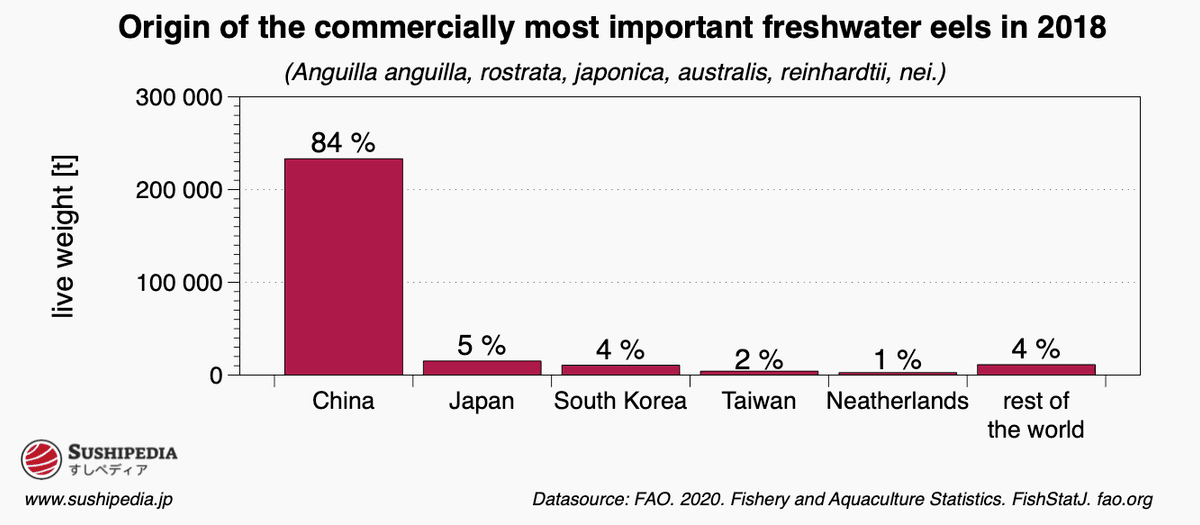
Sustainability
Unagi is a popular edible fish that has been fished in Japan and Europe for centuries and is valued as an ingredient. Growing consumer demand and the convergence of international trade flows in recent decades have increasingly contributed to its threat. The European eel is now considered to be in danger of extinction, while the Japanese and American eel, among others, are considered to be highly endangered. Since February 2013, the Japanese Ministry of Environment has officially listed the Japanese eel as a threatened species [MOE, 2013]. All species relevant as unagi are severely decimated in population size, although about 95 % of the consumed ungagi come from aquaculture, they are not bred in captivity. Instead, young eels (silver or glass eels) are taken from the wild and then reared in closed cultures and fattened until they are ready for slaughter.
Besides the excessive number of wild catches, the destruction of natural habitats, illegal fishing, and the fishing of juveniles for aquaculture poses an existential threat. Until the development of a so-called “complete aquaculture”, for which no glass eels have to be taken from the wild, a consumer must decide for himself to what extent each piece of unagi he orders affects the survival of the entire species.
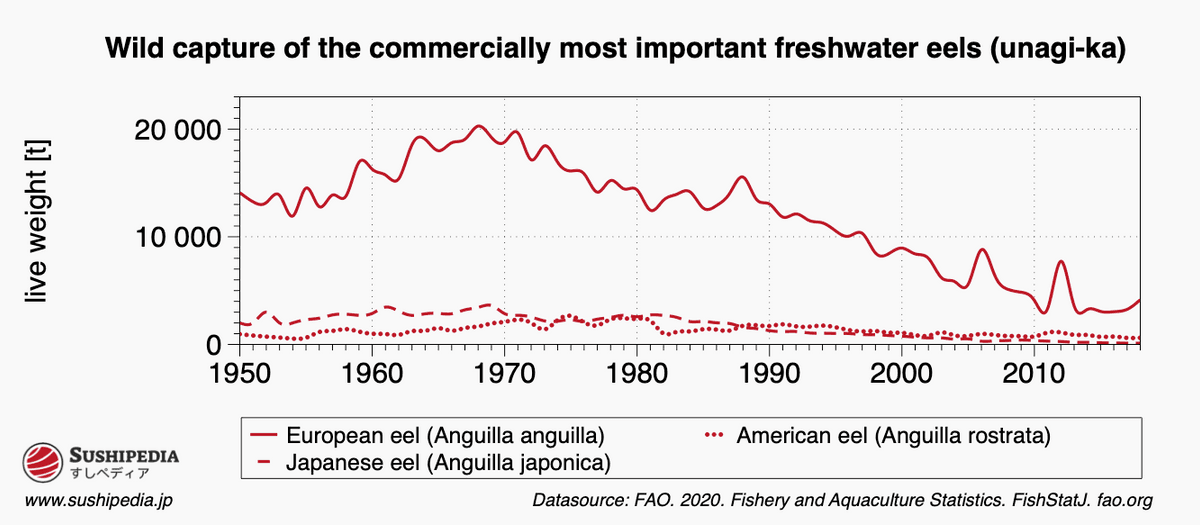
Aquaculture
The common practice is to raise juvenile eels (glass eels) from wild stocks in aquaculture. It is still not possible to breed commercially viable unagi in captivity. Artificially fertilised eggs and successful hatching have been repeatedly achieved under laboratory conditions. In 2002, the Aquaculture Research Institute at the Fisheries Research Centre in Mie Prefecture succeeded for the first time in the world in developing larvae into glass eels [AFFRC, 2010]. Research continues to face serious problems in terms of food supply, resource consumption and the need for hormonal feminisation of the spawn. Among the main issues that researchers are facing is the need for shark eggs as a food source for juvenile eel immediately after hatching, the need for daily water changes and hormonal feminisation, as the vast majority of fish fry from artificial environments are male [FRANEWS, 2010].
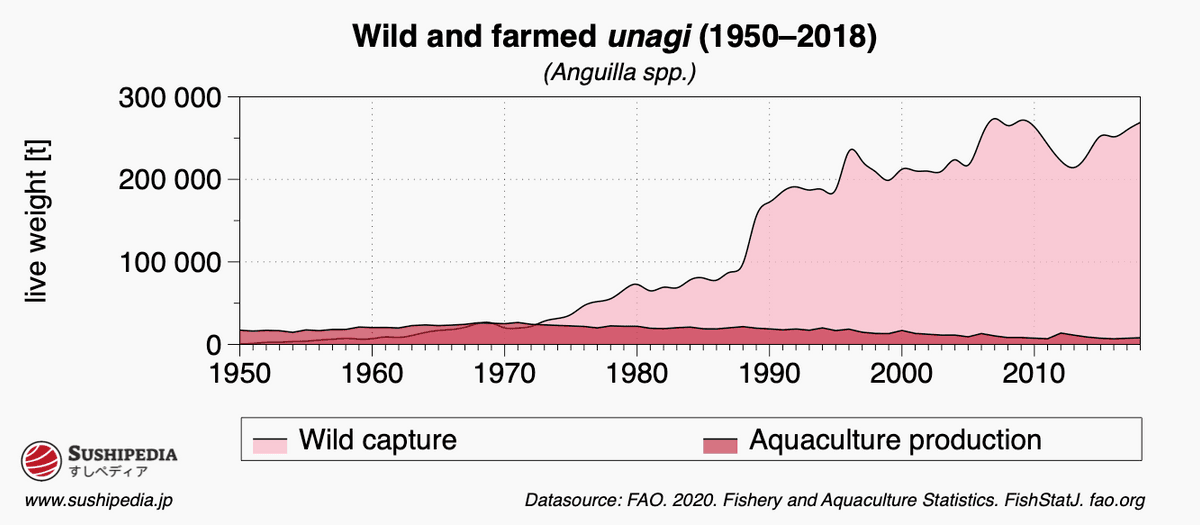
Gallery
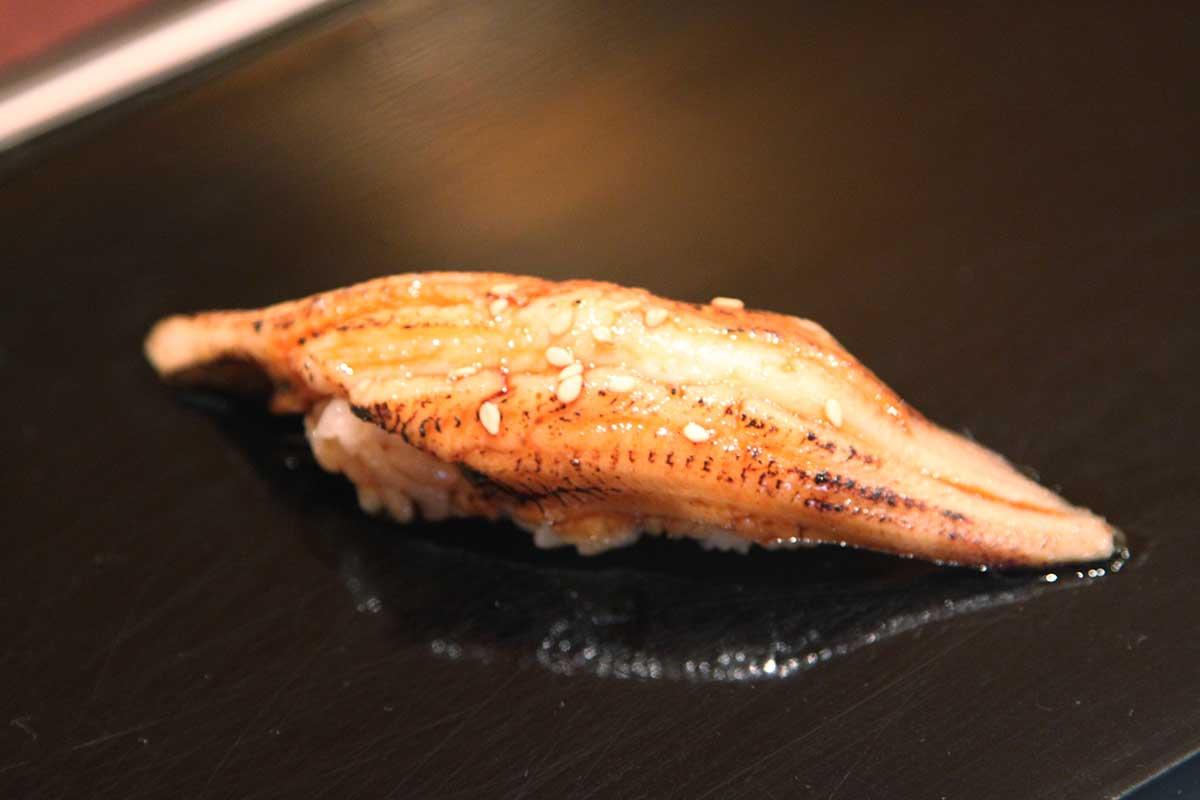
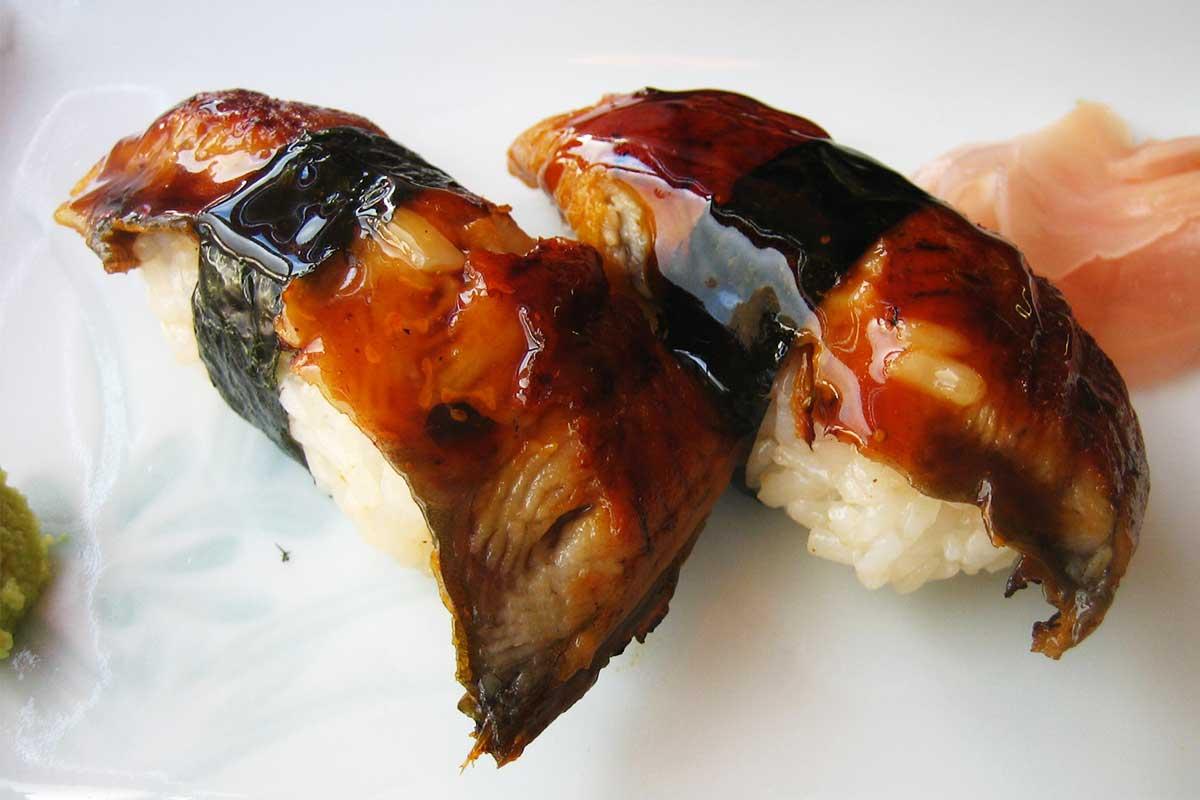
Further information on the author can be found in the section on image credits.
Video about Unagi
External video embedded from youTube.com: Eater. Chef Kanejiro Kanemoto Is Japan's Grilled Eel Master — Omakase
Species of Unagi
The following species are regarded as authentic. Either historically, according to the area of distribution or according to the common practice in today's gastronomy:
Japanese Name | Common Names, Scientific Name |
|---|---|
nihonunagi ニホヌナギ 日本鰻 | Japanese eel Anguilla japonica family: Anguillidae |
The following species can be considered subsitutes. Either on the basis of genetic relationship or because they are similar in taste or appearance:
Japanese Name | Common Names, Scientific Name |
|---|---|
bikaraunagi ビカラウナギ | amalona, bicolor eel, indian ocean eel Anguilla bicolor family: Anguillidae |
oounagi, oounagi オオウナギ、オオウナギ 大鰻 | giant long-finned eel, giant mottled eel Anguilla marmorata family: Anguillidae |
osutorariaunagi オストラリアウナギ | Australian short-finned eel, Australian shortfinned eel, eel Anguilla australis family: Anguillidae |
yoroppaunagi ヨロッパウナギ 欧羅巴鰻 | European eel, common eel, silver eel Anguilla anguilla family: Anguillidae |
References & Further Reading
- [AFFRC, 2010]: “世界初の「ウナギの完全養殖」、ついに成功!〜天然資源に依存しないウナギの生産に道を開く〜 ”, プレスリリース (engl. The world's first 'complete eel farming' finally succeeds! Paving the way for eel production that does not depend on natural resources, Press Release). Fisheries Research and Education Center (水産総合研究センター), Agriculture, Forestry and Fisheries Research Council (AFFRC) (農林水産技術会議), affrc.go.jp. 2010. Retrieved online on December 26, 2020.
- [FRANEWS, 2010]: Complete eel farming achieved (ウナギ 完全養殖達成). Fisheries Research Agency News, FRANEWS. Source.Volume 23. Japan Fisheries Research and Education Agency (FRA) (国立研究開発法人水産研究). 2010.
- [FishStatJ, 2021]: Fisheries and Aquaculture Department. Fishery and Aquaculture Statistics. Global production by production source 1950-2019 (FishstatJ). Food and Agriculture Organization of the United Nations (FAO), Rome. 2021. Retrieved online on May 12, 2021.
- [MOE, 2013]: Publication of the Fourth Red List (Brackish and Freshwater Fishes) 第4次レッドリストの公表について(汽水・淡水魚類). Ministry of the Environment (MOE) (環境省), Tokyo (東京), env.go.jp. 2013.
- [Ottolenghi et al., 2004]: Francesca Ottolenghi, Cecilia Silvestri, Paola Giordano, Michael B. New, Alessandro Lovatelli. Capture-based Aquaculture - The Fattening of Eels, Groupers, Tunas and Yellowtails. Food and Agriculture Organization of the United Nations. 2004.
- [Tsuji, 2012]: 辻泰弘編. 東西美味の品格-調理法で比べる東西の味わい-鰻 (engl. A Taste of East and West - Comparing East and West by Cooking Methods - Eel). Shogakukan (小学館). 2012.
Image Credits
takaokun. IMG_5614 Unagi Nigiri. flickr.com. License: Attribution 2.0 Generic (CC BY 2.0). Changes made: image quality, brightness, contrast, colour matching, sharpening, cropping.
Jeremy Keith. Unagi. flickr.com. License: Attribution 2.0 Generic (CC BY 2.0). Changes made: image quality, brightness, contrast, colour matching, sharpening, cropping.